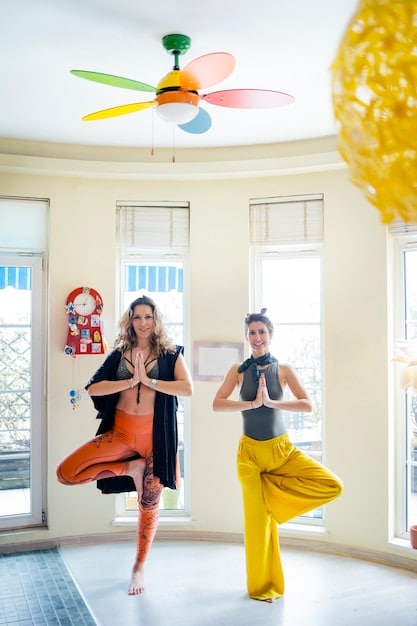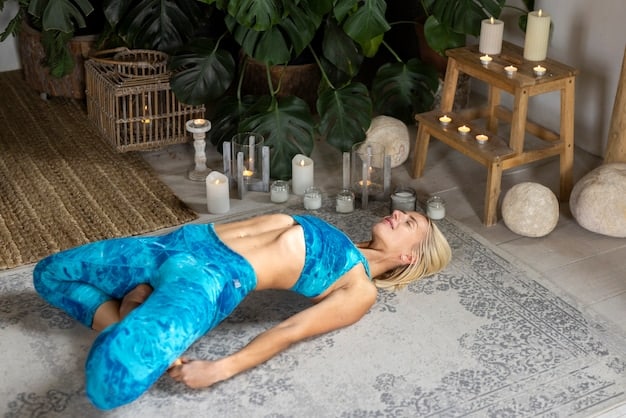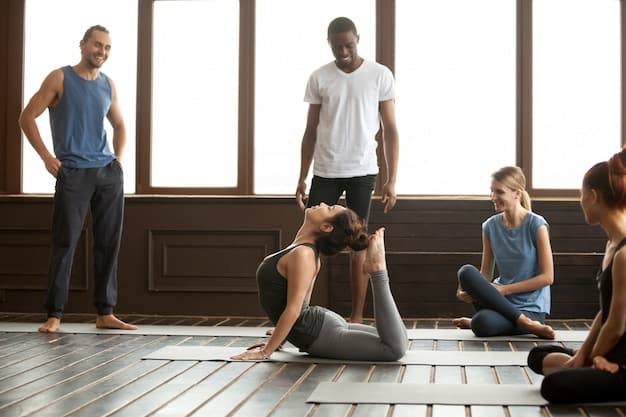The Latest Trends in Yoga: Aerial, Restorative, and More

The latest trends in yoga encompass practices like aerial yoga, which uses suspended fabrics to enhance flexibility, and restorative yoga, which focuses on deep relaxation and stress reduction, alongside evolving approaches to traditional forms.
Discover the **latest trends in yoga: exploring aerial yoga, restorative yoga, and more** to find innovative ways of enhancing your physical and mental well-being.
Explore Aerial Yoga and Its Benefits
Aerial yoga is a modern approach that combines traditional yoga poses with the use of a hammock or sling suspended from the ceiling. This practice allows for a unique experience, enhancing flexibility and providing a fun way to challenge your body.
By using the hammock, practitioners can achieve positions that might be difficult on the ground, promoting better alignment and deeper stretches. Let’s delve into the specific benefits that aerial yoga offers.
Enhanced Flexibility
One of the primary benefits of aerial yoga is the increased range of motion it provides. The hammock supports your weight, allowing you to stretch further and more safely than traditional floor-based yoga.
Core Strength
Engaging your core is essential in aerial yoga to maintain stability and control. The unstable nature of the hammock forces you to activate your core muscles continuously, leading to improved strength and stability.
- Decompression of the Spine: The hammock allows for gentle traction, decompressing the spine and alleviating back pain.
- Improved Circulation: Inversions in aerial yoga can improve blood flow, boosting circulation and overall cardiovascular health.
- Increased Body Awareness: The unique movements and positions of aerial yoga heighten your awareness of your body in space.
In conclusion, aerial yoga offers a dynamic and engaging way to enhance flexibility, build core strength, and improve overall body awareness. It’s a trend worth exploring for those looking to add an exciting twist to their yoga practice.
Restorative Yoga: A Path to Deep Relaxation
Restorative yoga is a practice focused on deep relaxation and stress reduction. Unlike more active styles of yoga, restorative yoga involves holding simple poses for extended periods, often with the support of props like blankets, bolsters, and blocks.
This gentle approach allows the body to fully relax, promoting a sense of calm and well-being. Let’s explore the key aspects of restorative yoga and why it has become a popular trend.

The Importance of Props
Props are essential in restorative yoga as they help support the body, allowing for complete relaxation. They eliminate the need for muscular effort, making the poses more accessible and comfortable.
Benefits for Mental Health
Restorative yoga is highly effective in reducing stress and anxiety. By activating the parasympathetic nervous system, it promotes relaxation and a sense of calm, improving overall mental well-being.
- Reduced Muscle Tension: The long-held poses help release tension in the muscles, alleviating pain and stiffness.
- Improved Sleep: Regular restorative yoga practice can improve sleep quality by calming the mind and body.
- Enhanced Self-Awareness: Taking time to relax and be present in the body can enhance self-awareness and mindfulness.
In summary, restorative yoga offers a profound path to deep relaxation and stress reduction. Its gentle approach and focus on support make it an accessible and beneficial practice for people of all ages and abilities.
Yoga for Every Body: Adaptive Yoga
Adaptive yoga is an increasingly popular trend that focuses on making yoga accessible to people of all abilities. This approach modifies traditional poses to accommodate physical limitations, ensuring that everyone can enjoy the benefits of yoga.
Whether you’re dealing with mobility issues, chronic pain, or other health conditions, adaptive yoga provides a safe and effective way to participate in this ancient practice. Let’s explore how adaptive yoga is changing the landscape of yoga.
Modifications and Support
Adaptive yoga utilizes various modifications and supports to make poses accessible. Chairs, walls, and other props are commonly used to provide stability and support, allowing individuals to participate comfortably.
Inclusivity and Empowerment
Adaptive yoga promotes inclusivity by creating a welcoming and supportive environment for all participants. It empowers individuals to take control of their health and well-being, regardless of their physical limitations.

- Improved Mobility: Adaptive yoga can help improve range of motion and flexibility, even for those with limited mobility.
- Pain Management: The gentle movements and stretches can help alleviate chronic pain and discomfort.
- Enhanced Mental Well-being: Participating in adaptive yoga can boost self-esteem, reduce stress, and improve overall mental well-being.
In conclusion, adaptive yoga is a transformative trend that makes yoga accessible to everyone, regardless of their physical abilities. By focusing on modifications, support, and inclusivity, it empowers individuals to experience the many benefits of yoga.
Yoga for Mental health: Trauma-Informed Yoga
Trauma-informed yoga is a specialized approach that recognizes the impact of trauma on the body and mind. This practice creates a safe and supportive environment where individuals can explore yoga as a tool for healing and self-regulation.
By understanding the unique needs of trauma survivors, trauma-informed yoga helps to promote a sense of empowerment, resilience, and well-being. Let’s delve into the principles and benefits of this increasingly important trend.
Creating a Safe Space
One of the core principles of trauma-informed yoga is creating a safe and predictable environment. This includes clear communication, gentle guidance, and empowering participants to make choices about their practice.
Empowerment and Choice
Trauma-informed yoga emphasizes empowerment and choice, allowing individuals to modify or opt out of poses as needed. This helps to build a sense of control and agency, which can be particularly beneficial for trauma survivors.
- Increased Self-Awareness: Trauma-informed yoga can help individuals become more aware of their body sensations and emotions, fostering a deeper connection to themselves.
- Improved Emotional Regulation: The practice can help regulate the nervous system, reducing anxiety and promoting emotional stability.
- Enhanced Sense of Safety: By creating a safe and supportive environment, trauma-informed yoga can help individuals feel more grounded and secure in their bodies.
In summary, trauma-informed yoga is a powerful trend that offers a safe and effective approach to healing from trauma. By prioritizing safety, empowerment, and choice, it provides a pathway to resilience and well-being.
Integrating Mindfulness with Yoga
Mindfulness has become an integral part of modern yoga practices, enhancing the benefits for both physical and mental well-being. Integrating mindfulness involves bringing conscious awareness to your breath, body, and thoughts during yoga.
This practice helps to deepen your connection to the present moment, reducing stress and promoting a sense of calm. Let’s explore how mindfulness is being incorporated into yoga and why it’s a growing trend.
Focus on the Breath
One of the key elements of mindfulness in yoga is focusing on the breath. Paying attention to the inhale and exhale helps to anchor you in the present moment, preventing the mind from wandering.
Body Scan Meditation
Body scan meditation involves bringing awareness to different parts of your body, noticing any sensations or tension. This practice can help to release physical and emotional blockages, promoting a sense of relaxation and well-being.
- Reduced Stress: Mindfulness helps to lower stress hormones and promote relaxation, improving overall mental and physical health.
- Enhanced Body Awareness: By paying attention to your body, you can become more aware of your physical limitations and needs, preventing injuries.
- Improved Mental Clarity: Mindfulness can help to clear the mind, improving focus and concentration.
In conclusion, integrating mindfulness with yoga is a powerful trend that enhances the benefits of both practices. By focusing on the present moment and cultivating awareness, you can deepen your connection to yourself and the world around you.
Yoga and Technology: Virtual Classes and Apps
Technology is transforming the way people practice yoga, with virtual classes and apps becoming increasingly popular. These innovations make yoga more accessible, convenient, and customizable, allowing individuals to practice from anywhere at any time.
Whether you’re looking for live online classes or guided meditations, technology-enhanced yoga offers a wealth of resources to support your practice. Let’s explore the trends in virtual yoga and apps.
Live Online Classes
Live online yoga classes provide a real-time interactive experience with a certified instructor. This allows for personalized feedback, community interaction, and the convenience of practicing from home.
Yoga Apps and Programs
Yoga apps offer a wide range of features, including guided meditations, pose tutorials, and customizable workout plans. These apps make it easy to track your progress, set goals, and stay motivated.
- Increased Accessibility: Virtual classes and apps make yoga accessible to people who may not have access to a studio or qualified instructor.
- Convenience: Technology-enhanced yoga allows you to practice on your own schedule, making it easier to fit into your busy life.
- Cost-Effective: Virtual classes and apps are often more affordable than traditional studio classes, making yoga accessible to a wider audience.
In short, yoga and technology combine to offer a convenient, accessible, and customizable way to practice. Whether through virtual classes or guided apps, you can easily integrate yoga into your daily routine.
Eco-Friendly Yoga: Sustainable Practices
As awareness of environmental issues grows, eco-friendly yoga is becoming an increasingly important trend. This approach focuses on minimizing the environmental impact of yoga practices through sustainable products, eco-conscious studios, and mindful consumption.
By making environmentally friendly choices, yoga practitioners can align their values with their practice, promoting a healthier planet for future generations. Let’s explore the key aspects of eco-friendly yoga.
Sustainable Yoga Products
Sustainable yoga products include mats made from natural rubber, clothing made from organic cotton, and props made from recycled materials. These products are designed to minimize environmental impact and support ethical production practices.
Eco-Conscious Studios
Eco-conscious yoga studios prioritize sustainability by using energy-efficient lighting, recycled materials, and non-toxic cleaning products. They also often offer recycling programs and encourage students to bring their own water bottles and towels.
- Reduced Carbon Footprint: By choosing sustainable products and practices, you can reduce your carbon footprint and minimize your impact on the environment.
- Support Ethical Production: Eco-friendly yoga supports ethical production practices, ensuring that workers are treated fairly and compensated adequately.
- Promote a Healthier Planet: By making environmentally conscious choices, you can contribute to a healthier planet for future generations.
In conclusion, eco-friendly yoga combines the ancient practice with a commitment to environmental stewardship. By choosing sustainable products, practices, and studios, you can align your yoga practice with your values, promoting a healthier planet for all.
| Key Point | Brief Description |
|---|---|
| 🧘 Aerial Yoga | Uses a hammock to enhance flexibility and spinal decompression. |
| 😌 Restorative Yoga | Focuses on deep relaxation and stress reduction with props. |
| ♿ Adaptive Yoga | Modifies poses for individuals with physical limitations. |
| 🌿 Eco-Friendly Yoga | Emphasizes sustainable products and practices. |
Frequently Asked Questions
▼
Aerial yoga combines traditional yoga poses with a suspended hammock, enhancing flexibility and allowing for spinal decompression.
▼
Restorative yoga promotes deep relaxation, reduces stress, and improves sleep quality through long-held, supported poses.
▼
Adaptive yoga is beneficial for individuals with mobility issues, chronic pain, or other physical limitations, making yoga accessible to all.
▼
Trauma-informed yoga creates a safe space for healing by promoting self-regulation and empowerment for trauma survivors.
▼
Eco-friendly yoga focuses on sustainable practices, using eco-conscious products and studios to minimize the environmental impact of yoga.
Conclusion
Exploring **the latest trends in yoga** reveals a dynamic landscape that honors tradition while embracing innovation. From the playful heights of aerial yoga to the grounding stillness of restorative practices, and the emphasis on Eco-Friendly Yoga, these trends reflect a commitment to making yoga accessible, inclusive, and beneficial for all. As you consider these modern approaches, remember to listen to your body, prioritize safety, and find the style that best suits your personal wellness goals.





